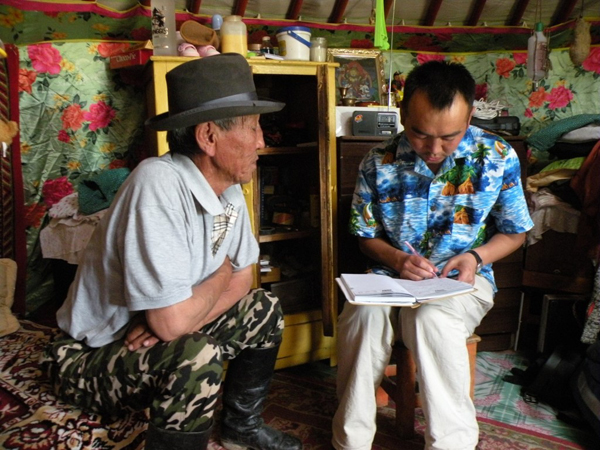Dr. Kathy Galvin offers her thoughts on conducting compelling interviews and shares her ideas about the important and oftentimes overlooked information that can be found in the pauses, the unstructured questions, and most of all, the ability to let go of preconceptions about what the interviewer hopes to find.
As appearing on Stanford Leopold Leadership 3.0 | 10.08.13
A Science and an art: What makes for an effective interview?

Note from Pam: Participants in our Leopold Leadership training programs learn how to create a network map for carrying forward a vision for change. A network map helps you visualize your relationships with others who work on the issue you care about. Understanding what that network looks like helps you identify points where you might engage. Informational interviewing is a critical skill for deepening your understanding of the issue and building long-term relationships for working on it effectively.
We asked Kathleen Galvin, a Professor of Anthropology and Senior Research Scientist at the Natural Resource Ecology Laboratory at Colorado State University and a Leopold Leadership Fellow, what makes for an effective interview. Kathleen works collaboratively with pastoralists, students, researchers, local governments, villages, and NGOs on climate adaptation in the drylands of east Africa and in northern Asia (Kenya and Mongolia in particular). Her work has resulted in new research and inputs to land management policies and practices for sustainability. For an overview, watch this 4-minute video.
Kathleen shares her insights below about two kinds of interviews used in the social sciences: one for exploratory research, the other for testing hypotheses.
If you’re building a network map, how might these two approaches help you expand your understanding of an issue and test parts of your vision for change?
The Effective Interview – Exploratory Research
I’m sitting in a pickup truck interviewing a rancher about his land use and land management strategies and how they have changed over the last two years under recurring droughts. I’m taking notes, listening, asking other questions that are not in the interview. There is a fine line between getting the information and carrying on a conversation. One way to do this smoothly, if given permission, is to record the interview. Issues and information emerge that I was not looking for but are important for understanding. Doing effective interviewing is a science and an art.
There are several types of interviews – in-depth, open-ended interviewing is a way to learn about a topic, like a rancher’s management strategies. There are no correct answers and it is a means to learn about something about which little is known. But it requires logical thinking and excellent communication skills and the general questions are planned. This demands clear objectives for the interview. It also requires humility on the part of the interviewer and the willingness to always ask about meanings of terms and clarification of details.
A semi-structured interview consists of a predetermined set of questions about a domain of interest administered to a representative sample of respondents to identify variables for analysis or use in a survey. The questions are formed; the answers are open-ended. Both of these types of interviews are preparation for more systematic forms of investigation and are used to develop hypotheses.
Remember, you are listening to what matters to your informants, not to you. Interviews are a first step to a survey.
The Survey – Explanatory Research
To begin you need to introduce yourself and the project, ensure confidentiality and explain why their views and information are important. Try and make people comfortable by making culturally important small talk. Put yourself into their shoes for a minute and imagine, for example, what that rancher in his truck thinks about an academic asking him questions – maybe it’s time for a good joke!
Based on interview data, I hypothesized that rich ranchers have diversified their land use under droughts more than poor ranchers. I also hypothesized that diversity is a drought coping strategy. To test these hypothesizes requires all the same scientific procedures that occur in the natural sciences. In this case, avoid open-ended questions and make sure the questions are relevant to the topic. Always pretest the survey on a subsample of the population first. Make sure the questions use terms and phrases that are understandable to respondents. If answers are confusing or inappropriate the wrong questions are probably being asked or being asked in unclear ways. Keep questions short and ask only one question at a time. Do not ask questions that are biased or lead the respondent to answers. Be sensitive to the cultural context or social meanings of words or questions. Key informants are important in this regard. It is important to find a few people who are especially knowledgeable about the topic; ask them to help pretest the survey.
The best way to learn how to conduct an effective interview or develop a good survey is to take a social science methods class. Altamira Press and Sage Publications have great books on interview and survey methodologies and there are wonderful software packages that can analyze and quantify qualitative data (e.g., NVivo, Atlas ti, MAXQDA). There are many quantitative data analysis programs familiar to natural scientists.
Have fun! I did my anthropological dissertation research in the field with an ecology graduate student who was doing camel bite counts (that’s another story) and both he and I can affirm I had more fun!
Kathleen Galvin is a Professor in the Department of Anthropology and Senior Research Scientist at the Natural Resource Ecology Laboratory at Colorado State University. Read more here and visit her Sustainable African Ecosystems and Societies Research Group website. She and her collaborators have a new 10-minute video,“The Maasai Voices on Climate Change (and other changes, too).” This participatory documentary, made by young Maasai pastoralists, will be awarded the Jean Rouch Award for Collaborative Filmmaking by the Society for Visual Anthropology at the American Anthropological Association meeting in November.